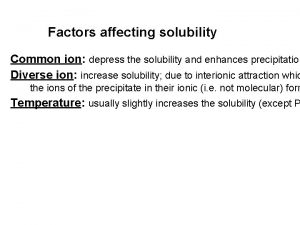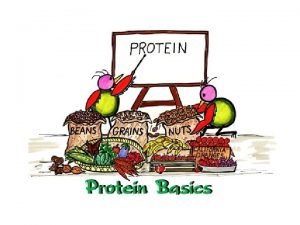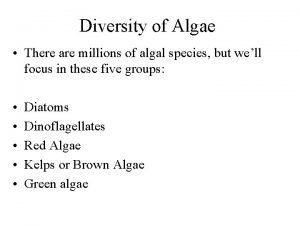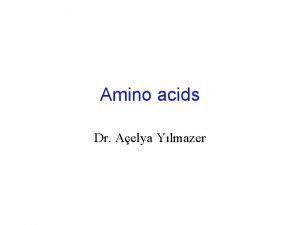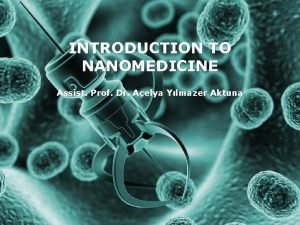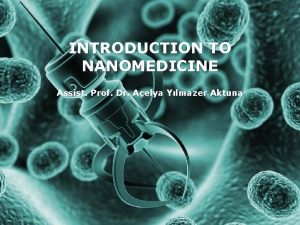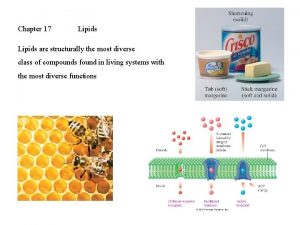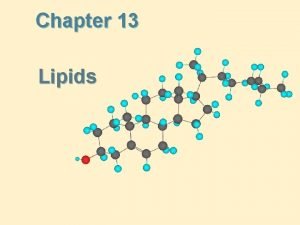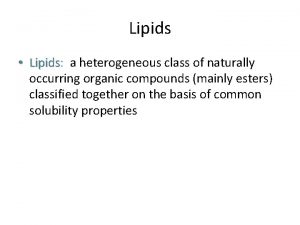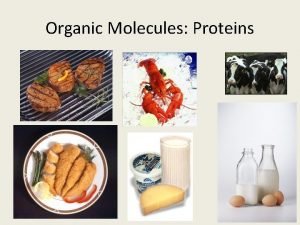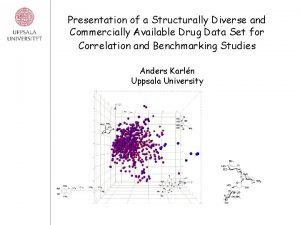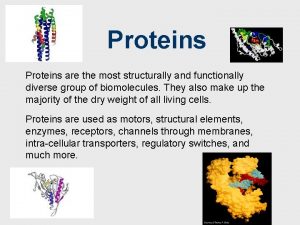Lipids Dr Aelya Ylmazer Lipids Structurally Diverse Class














- Slides: 14

Lipids Dr. Açelya Yılmazer

Lipids: Structurally Diverse Class • Low solubility in water • Good solubility in nonpolar solvents

Biological Functions of Lipids • Storage of energy – Reduced compounds: lots of available energy – Hydrophobic nature: good packing • Insulation from environment – Low thermal conductivity – High heat capacity (can “absorb” heat) – Mechanical protection (can absorb shocks) • Water repellant – Hydrophobic nature: keeps surface of the organism dry • Prevents excessive wetting (birds) • Prevents loss of water via evaporation • Buoyancy control and acoustics in marine mammals – Increased density while diving deep helps sinking (just a hypothesis) – Spermaceti organ may focus sound energy: sound stun gun?

More Functions • Membrane Structure – Main structure of cell membranes • Cofactors for enzymes – Vitamin K: blood clot formation – Coenzyme Q: ATP synthesis in mitochondria • Signaling molecules – – Paracrine hormones (act locally) Steroid hormones (act body-wide) Growth factors Vitamins A and D (hormone precursors) • Pigments – Color of tomatoes, carrots, pumpkins, some birds • Antioxidants – Vitamin E

Classification of Lipids • Based on the structure and function • Lipids that do not contain fatty acids: cholesterol, terpenes, … • Lipids that contain fatty acids (complex lipids) – Storage lipids and membrane lipids

Fatty Acids • Carboxylic acids with hydrocarbon chains containing from 4 to 36 carbons • Almost all natural fatty acids have an even number of carbons • Most natural fatty acids are unbranched • Saturated: no double bonds between carbons in the chain • Monounsaturated: one double bond between carbons in the alkyl chain • Polyunsaturated: more than one double bond in the alkyl chain

Fatty Acid Nomenclature

Solubility and Melting Point of Saturated Fatty Acids • Solubility decreases as the chain length increases • Melting point increases as the chain length increases

Conformation of Fatty Acids • The saturated chain tends to adopt extended conformations • The double bonds in natural unsaturated fatty acids are commonly in cis configuration • This introduces a kink in the chain

Melting Point and Double Bonds • Saturated fatty acids pack in a fairly orderly way – extensive favorable interactions • Unsaturated cis fatty acid pack less regular due to the kink – Less extensive favorable interactions • It takes less thermal energy to disrupt disordered packing of unsaturated fatty acids: – unsaturated cis fatty acids have a lower melting point

Trans Fatty Acids • Trans fatty acids form by partial dehydrogenation of unsaturated fatty acids • A trans double bond allows a given fatty acid to adopt an extended conformation. • Trans fatty acids can pack more regularly, and show higher melting points than cis forms

Trans Fatty Acids in Foods • Consuming trans fats increases risk of cardiovascular disease – Avoid deep-frying partially hydrogenated vegetable oils – Current trend: reduce trans fats in foods (Wendy’s, KFC)

Triacylglycerols (fats and oils) • Majority of fatty acids in biological systems are found in the form of triacylglycerols • Solid ones are called fats • Liquid ones are called oils • Triacylglycerols are the primary storage form of lipids (body fat) • Triacylglycerols are less soluble in water than fatty acids due to the lack of charged carboxylate group • Triacylglycerols are less dense than water: fats and oils float

Fats Provide Efficient Fuel Storage • The advantage of fats over polysaccharides: – Fatty acid carry more energy per carbon because they are more reduced – Fatty acids carry less water along because they are nonpolar • Glucose and glycogen are for short-term energy needs, quick delivery • Fats are for long term (months) energy needs, good storage, slow delivery
 How does it move
How does it move Enes ylmazer
Enes ylmazer Chapter 16 section 2 transcaucasia
Chapter 16 section 2 transcaucasia We live in a diverse world
We live in a diverse world Surface level diversity
Surface level diversity More diverse
More diverse Nh3ag
Nh3ag The kingdom protista contains
The kingdom protista contains Career development of diverse populations
Career development of diverse populations Diverse societies in africa
Diverse societies in africa Contains the most diverse eukaryotic organisms
Contains the most diverse eukaryotic organisms Most diverse biomolecules
Most diverse biomolecules One syllable adjectives
One syllable adjectives Diverse expenses
Diverse expenses Algae diversity
Algae diversity






